How
One Good Idea By One Artist
Changed Portrait Painting Forever
An Artist's
Extraordinarily Good Idea
Reshaped the History of the Profession
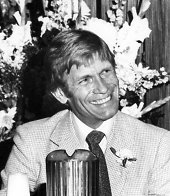
Robert Bruce
Williams, 1979 |
 obert
Bruce Williams is an American portrait painter
who, almost single-handedly, brought about a
total transformation—a revolution, really—in the profession of portrait painting.
I want to tell you his story, because it is
an amazing story, and even though I will be
recounting events from the very recent past,
there are many today who are not aware of this
chapter of history. A number of important innovations
grew out of the career of Robert Bruce Williams,
but I want to focus on one of his innovations—an extraordinarily good idea—which
all by itself turned the profession of portrait
painting into an entirely new direction. obert
Bruce Williams is an American portrait painter
who, almost single-handedly, brought about a
total transformation—a revolution, really—in the profession of portrait painting.
I want to tell you his story, because it is
an amazing story, and even though I will be
recounting events from the very recent past,
there are many today who are not aware of this
chapter of history. A number of important innovations
grew out of the career of Robert Bruce Williams,
but I want to focus on one of his innovations—an extraordinarily good idea—which
all by itself turned the profession of portrait
painting into an entirely new direction.
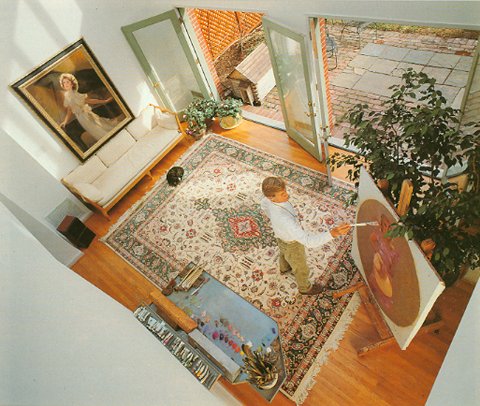
Robert Bruce Williams in his Washington,
DC studio |
Robert Williams, who today lives in retirement
in rural Maryland, had a meteoric and in many
ways unparalleled career in American portrait
painting. Dashingly handsome, he was for nearly
five decades a whirlwind of activity and energy,
traveling constantly and fulfilling an astonishing
number of portrait commissions. Unmarried throughout
most of his adult life, he had the looks and
presence of a film star. Robert and I were associated
in the National Portrait Seminars in the 1970's
and 80's, where his charisma and enthusiasm
were experienced by thousands of artists during
his brilliant demonstrations.
I first met Robert Williams in the auditorium
at the Art Students League of New York in September
of 1973. This was the first day of my first
announced ten-week lecture/demonstration series
on portrait painting. The gallery was packed
with a sold-out audience, and there in the front
row sat this strikingly handsome, slender young
man who introduced himself to me as artist Robert
Bruce Williams of Washington, DC. With him was
his even younger friend, artist Steven Moppert
of Jackson, Mississippi. The two had seen the
announcement about the lecture series, and had
traveled from Washington to be present. The
two young artists thereafter came every Monday
night for the next ten weeks, and we became
fast friends.
I learned that Robert was based in Washington,
and had his studio there (at that time a beautiful
stone townhouse on Dupont Circle), but that
he traveled incessantly across the United States,
painting portrait commissions. I was aware of
his name, because at that time Robert was really
the only portrait artist in America who did
regular full-page space advertising in major
magazines. This was one of his innovations,
and to this day no other artist has made as
extensive use of magazine advertising as Robert
did. As we talked over the next few weeks, I
learned quickly of another important innovation
that Robert had put into place in the course
of his career.
A REVOLUTIONARY MARKETING CONCEPT
In several locations, mostly in the southern
states, where he had had a significant local
success, he thereafter used the services of
local salespersons to secure additional commissions
for him. These agents were normally young women
who had been the subjects of one of his portraits.
Well-pleased with their portrait, these young
women—all of whom were socially prominent
in their communities—were well-placed
to network with their friends and peers to obtain
further assignments for Robert. In fact, so
successful were these youthful representatives,
that Robert was able to return to their communities
and find as many as a dozen assignments at one
time, awaiting his attention. This arrangement,
repeated multiple times across the South and
the Midwest, resulted in Robert Williams being
perhaps, at that time, the busiest portrait
artist in America.
These representatives received a percentage
of the sale price of each portrait. Thus they
were highly motivated to identify multiple customers
for their famous artist client. The highly developed
skill of the artist assured the success and
popularity of the undertaking. Both the representatives
and the artist found the arrangement to be very
financially rewarding. In fact, the success
in several instances was on a scale so dramatic
that one artist—however skilled and energetic—was not capable of meeting all of the
demands. The logical next step was for the representative
to add additional artists to help fulfill the
commissions that were coming in.
THE BIRTH OF "PORTRAITS SOUTH"
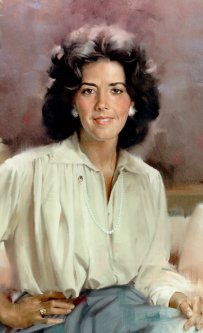
Suzanne McKinney
Detail from the portrait by
John Howard Sanden |
|
In Raleigh, North Carolina, one young lady,
Suzanne McKinney, found herself with an overwhelming
number of portrait commissions. She needed artists,
in addition to Robert, to fulfill these expectations.
Suzanne came to New York and visited in my studio
for advice. I was happy to recommend to her
a list of artists. Suzanne also realized that
if, working by herself, and with only one artist,
she was able to generate this kind of demand
for portraiture, she could expand by adding
additional representatives as well as artists.
It was from this idea—and this enthusiasm—that the first of the important nationwide
phenomena of regional (later national) portrait
agencies was born. Suzanne called her company
Portraits South.
But before Portraits South could spring fully
grown into existence, however, there was one
important detour that had to be taken. Suzanne's
original idea had been not to create a new entity,
but to bring her exciting idea to the attention
of the one important portrait agency in America
at that time. That would be Portraits, Incorporated
in New York.
SETBACK IN NEW YORK
In 1980, Portraits Inc., operating from its
conspicuous and prestigious location at the
heart of the art capital of the world, essentially
had the portrait market in America all to itself.
Suzanne McKinney saw her role as providing a
way for Portraits, Inc. to greatly increase
its market share across the country through
a network of representatives (salespersons)
which Suzanne would create and supervise on
their behalf. It was a sensational idea.
Suzanne made an appointment with the leadership
at Portraits, Inc. and came to New York to present
her idea, and to offer it to the New York gallery.
I recall that Suzanne brought her mother with
her for moral support, and the two ladies came
to my studio on West 58th Street for a bit of
reinforcement and prepping before their appointment
at the gallery. I was positive that the people
at Portraits, Inc. would literally jump at the
idea.
|
The National
Portrait Seminar
Plays Its Part In the Story
The first national conference for
portrait artists was The National
Portrait Seminar, presented by The
Portrait Institute in New York City,
1979-1982, Washington DC in 1983,
Chicago in 1984, and Atlanta in
1990 and 1993. The faculty leaders
at all of these meetings were Robert
Bruce Williams, Gordon Wetmore,
Margaret Holland Sargent, Patricia
Hill Burnett and John Howard Sanden.
It was at these national conferences
that Williams' leadership and example
attracted national attention.

The National Portrait Seminar panel,
1979, from left: Robert Bruce Williams,
Gordon Wetmore, and Margaret Holland
Sargent.
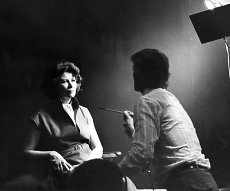
Robert Bruce Williams
painting Meg Sargent,
New York, 1979.
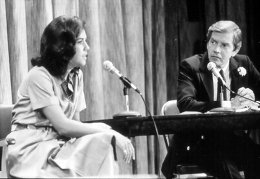
Suzanne McKinney being interviewed
by the Seminar chairman, John Howard
Sanden.
|
|
So I was astonished to learn later that day
that the idea had been turned down. And not
just turned down, but completely rejected. Suzanne
McKinney was not deterred however, and returned
to Raleigh to immediately organize the entity
that became known as Portraits South. This was
her concept: a central office, supervising and
coordinating a network of thirty to forty representatives,
all of whom were socially prominent young matrons.
These representatives were able to offer the
services of a list of leading American portrait
artists who would be willing to travel from
their locations to the assignment. This was
the idea that revolutionized the profession
of portrait painting in America, and it grew
directly out of the experience Suzanne had had
in representing one artist, Robert Bruce Williams.
THE IDEA WORKS AGAIN
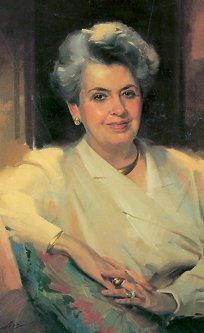
Harriet Keenan
Detail from the portrait by
John Howard Sanden |
|
The success of Suzanne McKinney which resulted
in the formation of Portraits South was repeated
in Columbia, South Carolina. There, Harriet
Keenan, wife of a prominent local real estate
executive and herself a leading figure in Columbia
social and civic circles, began discovering
customers for Robert Bruce Williams among her
many friends and acquaintances.
Soon Columbia became, like Raleigh, a focal
point for Robert's portrait work. In time here,
just as in Raleigh, the demand for portraits
outstripped Robert's capacity to supply. Harriet
began representing other portrait artists (myself
included). Out of this effort—when Harriet
teamed with Beverly McNeil of Birmingham, Alabama—came the extremely successful firm of
Portrait Brokers of America.
More than thirty years have passed since these
two stories that I have related. Today we find
a situation in which the number of independent
agencies and portrait brokerages have multiplied
across the country, with Portraits South and
Portrait Brokers of America still remaining
in leadership positions in the profession.
Recently, the firm in New York which resisted
Suzanne McKinney's revolutionary approach—namely, Portraits, Inc.—was actually
purchased by Portrait Brokers of America. This,
in a way, puts the final stamp of approval on
the remarkable marketing concept that grew directly
out of the career of one artist—Robert
Bruce Williams.
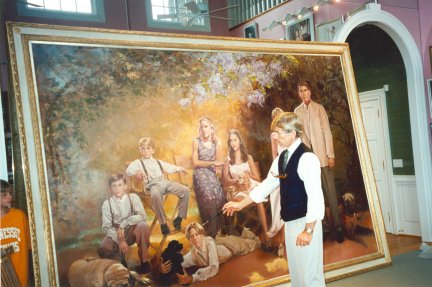
Completing a
family group portrait, 1995 |
John Howard Sanden with
Robert Bruce Williams,
Bennington, Vermont,
2003. |
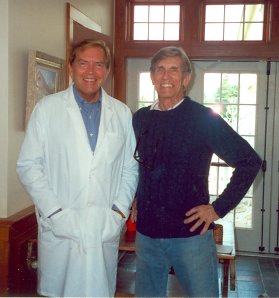 |
|